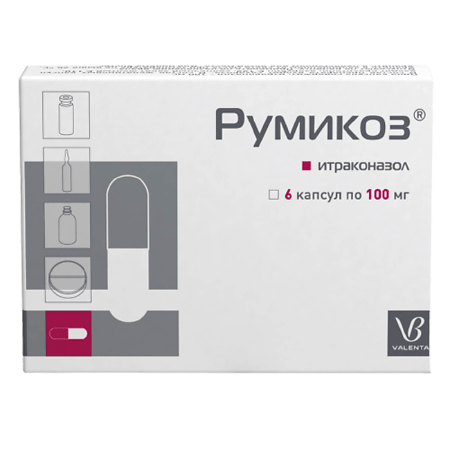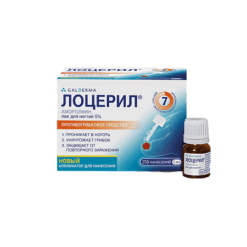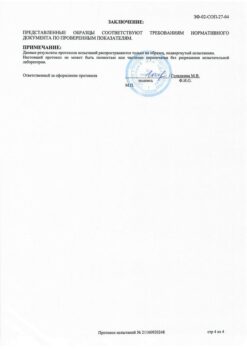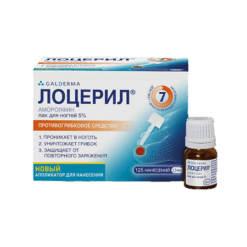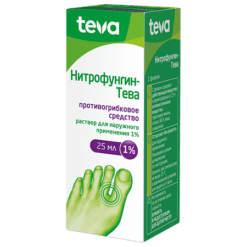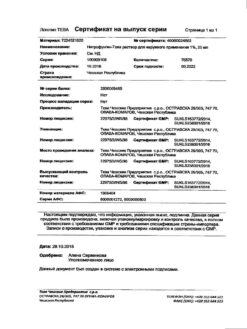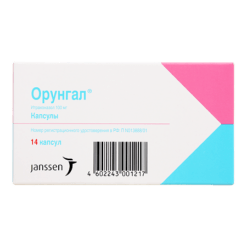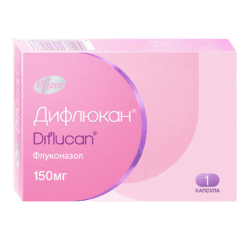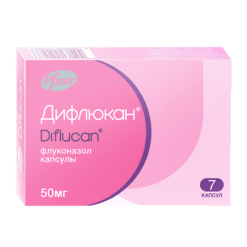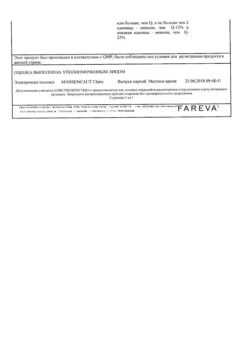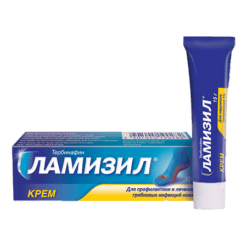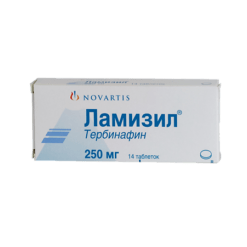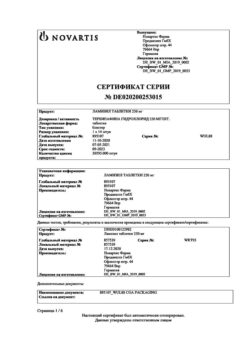No products in the cart.
Rumicose, 100 mg capsules 6 pcs
€21.90 €18.25
Description
Rumicose is a broad-spectrum antifungal.
Pharmacodynamics
A broad-spectrum synthetic antifungal agent, a triazole derivative.
Inhibits the synthesis of ergosterol which is an important component of the cell membrane of fungi.
It is active against dermatophytes (Trichophyton spp., Microsporum spp., Epidermophyton floccosum), yeast-like fungi and yeasts (Cryptococcus neoformans, Pityrosporum spp., Trichosporon spp.,Geotrichum spp., Candida spp. including C. albicans, C. glabrata and C. krusei), Aspergillus spp., Histoplasma spp., Paracoccidioides brasiliensis, Sporothrix schenckii, Fonsecaea spp., Cladosporium spp., Blastomyces dermatitidis, Pseudallescheria boydii, Penicillium marneffei and other yeast and mold fungi.
Pharmacokinetics
Introduction
In oral administration maximum bioavailability of itraconazole is observed when taking capsules immediately after meals. Tmax in plasma is 3-4 hours after oral administration.
Distribution
The plasma Css of itraconazole is 0.4 µg/ml (when taking 100 mg once daily), 1.1 µg/ml (when taking 200 mg once daily) and 2 µg/ml (when taking 200 mg twice daily). With prolonged use Css is achieved within 1-2 weeks. Binding to plasma proteins is 99.8%.
Itraconazole penetrates and distributes well in tissues and organs. Concentration of the drug in lungs, kidneys, liver, spleen, bones, stomach, skeletal muscles is 2-3 times higher than the corresponding concentration in plasma. Accumulation of the drug in keratinous tissues, especially in skin, is about 4 times higher than in plasma, and the excretion rate depends on the rate of epidermal regeneration. Unlike plasma concentration, which is undetectable as early as 7 days after discontinuation of therapy, therapeutic concentration in skin is maintained for 2-4 weeks after discontinuation of 4-week treatment course; in vaginal mucosa – for 2 days after 3-day treatment course in a dose of 200 mg once a day and for 3 days after 1-day treatment course in a dose of 200 mg twice a day. Therapeutic concentration of the drug in nail keratin is determined 1 week after the start of treatment and maintained for 6 months after the completion of 3-month course of therapy. Itraconazole is also determined in the secretion of sebaceous and sweat glands.
Metabolism
Metabolized in the liver with the formation of active metabolites, one of which – hydroxyitraconazole – has comparable with itraconazole antifungal effect in vitro.
Elimation
Elimation from plasma is biphasic with a final T1/2 of 24-36 hours.
Elevation in the feces is 3 to 18% of the dose, by the kidneys less than 0.03% of the dose; approximately 35% of the dose is excreted as metabolites in the urine within 1 week.
Pharmacokinetics in special clinical cases
In patients with renal insufficiency, as well as in some patients with impaired immunity (e.g., AIDS, after organ transplantation, neutropenia) the bioavailability of itraconazole may decrease. In patients with liver cirrhosis the bioavailability of itraconazole is decreased, T1/2 is increased.
Indications
Indications
Active ingredient
Active ingredient
Composition
Composition
One capsule contains:
The active ingredient:
Itraconazole pellets – 464.00 mg,
itraconazole – 100.00 mg,
Sugar pellets (sucrose – 80.0-91.5%, corn starch – 8.5-20.0%, water – maximum 1.5%) – 207.44 mg,
pellets/p>
poloxamer 188 (Lutrol) – 25.94 mg,
micronized poloxamer 188 (Lutrol) – 0.51 mg,
hypromellose – 130.11 mg.
Capsule shell composition:
Case: titanium dioxide E 171, gelatin;
Cap: titanium dioxide E 171, azorubin dye E 122, sunset yellow dye E 110, quinoline yellow dye E 104, iron oxide red dye E 172, iron oxide black dye E 172, gelatin.
How to take, the dosage
How to take, the dosage
Internal, after meals.
Interaction
Interaction
Drugs affecting absorption of itraconazole
Drugs that reduce the acidity of gastric juice reduce absorption of itraconazole.
Drugs affecting the metabolism of itraconazole
Itraconazole is mainly broken down by the enzyme CYP3A4. In concurrent use of itraconazole with rifampicin, rifabutin, phenytoin, carbamazepine, isoniazid, which are potent inducers of CYP3A4, bioavailability of itraconazole and hydroxyitraconazole decreases significantly, which leads to a significant reduction of the drug effectiveness. Concomitant use of Rumicose® with these drugs, which are potential inducers of hepatic enzymes, is not recommended.
Powerful inhibitors of CYP3A4 enzyme (e.g. ritonavir, indinavir, clarithromycin, erythromycin) may increase the bioavailability of itraconazole.
The effect of itraconazole on the metabolism of other drugs
Itraconazole may inhibit the metabolism of drugs cleaved by CYP3A4 enzyme. This may result in strengthening or prolongation of their effects, including side effects. After discontinuation of treatment with Rumicose® , plasma concentrations of itraconazole decrease gradually, depending on the dose and duration of treatment (see “Pharmacokinetics”). This should be taken into account when discussing the inhibitory effect of itraconazole on concomitant drugs.
Preventive medications that should not be administered concomitantly with Rumicos®
BTCs. In addition to possible pharmacokinetic interaction related to the common metabolic pathway involving CYP3A4 enzyme, BKDs may have a negative inotropic effect which is increased when taken concomitantly with Rumicoz®.
Drugs that should be monitored during concomitant administration for plasma concentrations, effects, side effects. If necessary, the dose of these drugs should be reduced:
Special Instructions
Special Instructions
Women of childbearing age taking Rumicose® should use adequate contraception for the duration of treatment until the first menstrual period after completion.
In a study of the IV dosage form of itraconazole, a transient asymptomatic decrease in left ventricular ejection fraction was observed, which normalized before the next infusion of the drug.
Itraconazole has been found to have a negative inotropic effect. Cases of heart failure associated with taking Rumicose® have been reported. Rumicose® should not be administered to patients with chronic heart failure or a history of this disease, except in cases when the possible benefit significantly exceeds the potential risk.
The BCCs may have a negative inotropic effect, which may potentiate the similar effect of itraconazole; itraconazole may decrease metabolism of BCCs. Caution should be exercised when concomitant administration of itraconazole and BCAA.
In patients with renal impairment, the bioavailability of itraconazole may be reduced, which may require dose adjustment.
In patients with decreased gastric acidity, absorption of itraconazole is impaired. In patients taking antacids (e.g. aluminum hydroxide), it is recommended to use them not earlier than 2 hours after taking Rumicose®. Patients with achlorhydria or who use histamine receptor H2-blockers or proton pump inhibitors are recommended to take Rumicos® capsules with acidic beverages.
In very rare cases severe toxic liver damage, including cases of acute hepatic failure with lethal outcome, have developed when using Rumicose®. This occurred in patients who already had liver disease, as well as in patients who received other drugs with hepatotoxic effects. Several such cases occurred in the 1st month of therapy, and some in the 1st week of treatment. That is why it is recommended to monitor liver function regularly in patients receiving itraconazole therapy.
The treatment should be stopped if neuropathy occurs, which may be associated with taking Rumicos® capsules.
There are no data on cross-sensitivity to itraconazole and other azole antifungal drugs. Rumicose® capsules should be used with caution in patients with hypersensitivity to other azoles.
In patients with impaired immunity (AIDS, after organ transplantation, neutropenia) an increase in the dose of Rumicos® may be necessary.
Impact on the ability to drive vehicles and operate machinery. Not observed
Influence on the ability to drive vehicles and operate machinery.
Synopsis
Synopsis
Contraindications
Contraindications
With caution: children; severe heart failure; liver disease (including those with hepatic insufficiency); chronic renal failure.
Side effects
Side effects
Gastrointestinal disorders: dyspepsia, nausea, vomiting, decreased appetite, abdominal pain, diarrhea, constipation.
Hepatobiliary system: reversible increase in liver transaminase activity, hepatitis; very rare – severe toxic liver damage, including acute liver failure with lethal outcome.
Nervous system disorders: headache, dizziness, peripheral neuropathy.
Allergic reactions: skin rash, skin itching, urticaria, angioedema, rarely – erythema multiforme (Stevens-Johnson syndrome).
Skin disorders: alopecia, photosensitivity.
Others: menstrual irregularities, hypokalemia, edema syndrome, congestive heart failure and pulmonary edema, hypercreatininemia, dark coloring of urine.
Overdose
Overdose
No data available.
Treatment:
In case of accidental overdose, gastric lavage within the first hour, if necessary – administration of activated charcoal. Itraconazole is not excreted by hemodialysis.
There is no specific antidote for the drug.
Pregnancy use
Pregnancy use
Pregnant women should be prescribed Rumicos® only in life-threatening cases if the expected benefit to the woman exceeds the potential risk to the fetus.
Breastfeeding should be stopped if prescribed during lactation.
Similarities
Similarities
Additional information
| Shelf life | 3 years |
|---|---|
| Conditions of storage | In a dry, light-protected place at a temperature not exceeding 25 °C |
| Manufacturer | Valenta Farm, Russia |
| Medication form | capsules |
| Brand | Valenta Farm |
Related products
Buy Rumicose, 100 mg capsules 6 pcs with delivery to USA, UK, Europe and over 120 other countries.

